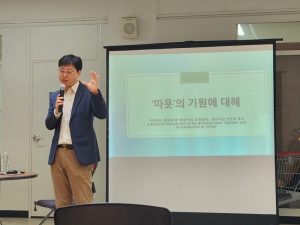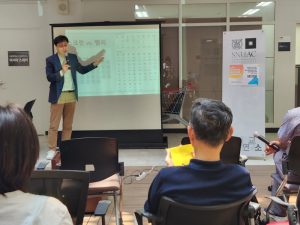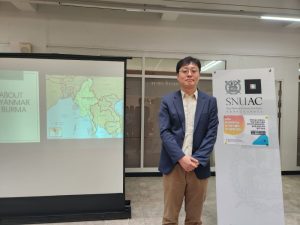Examining the Burmese Term ‘Tayoke’ and Its Connection to ‘China’ from a Eurasian Perspective
- Date: June 4th, Thursday, 2024, 12:00 – 13:00
- Location: Asia Square (3F), SNUAC (Bldg. 101)
Presenter: Hojai Jung (Visiting Scholar, SNUAC)
Moderator: Dae-yeong Youn (HK Research Professor, SNUAC)
On June 4, 2024, Dr. Hojai Jung, a visiting scholar at SNUAC, delivered a presentation titled “Examining the Burmese Term ‘Tayoke’ and Its Connection to ‘China’ from a Eurasian Perspective” during the institute’s brown bag seminar at Asia Square. He explained that the objective of this study was to focus on the term “Tayoke” (or “Tayok”) used in Myanmar to refer to China and to propose a rational interpretation of its origin. He hypothesized that this naming might have originated from the “Da Yo State” created by the Khitan people of China.
Dr. Jung argued that the term “Tayok” or “Tayoke,” widely used in Myanmar to refer to mainland China, is unique from a global perspective. He noted that this name has been used in Myanmar for nearly a millennium to denote Chinese dynasties. It serves as a prime example of the unique and isolated political relationship between Burma and China. He explained that the region of Myanmar has a complex history due to its intersections with various civilizations, including southern China, Tibet, Sri Lanka, and India. Despite the global diversity in names for the ancient civilization of China, “Tayok” stands out as an unprecedented name from an Asian perspective. Therefore, he emphasized the need to examine it from a phonetic perspective, through comparisons with neighboring countries, and in the context of Myanmar’s historical state formation.
However, he also acknowledged the difficulty of precisely tracing the origin of this term due to the scarcity of historical records in Myanmar. Nonetheless, he cited an example where some scholars speculate that the term might have originated from the Chinese term “Dayue” (大粤), used to refer to a region in southern China where Cantonese is spoken. Another hypothesis mentioned the Burmese term “Daruk” for Turks, suggesting a connection with the Turkic armies involved in the Mongol invasions of Burma in the 13th century. Despite the various theories, Dr. Jung concluded that the term “Tayok” reflects the close historical, cultural, and social ties between Myanmar and China and is an important part of Myanmar’s cultural and linguistic heritage. He also speculated that it could play a crucial role in shaping regional identity in the context of Myanmar’s relationship with China.
Dr. Jung emphasized the need to analyze the term from a Eurasian perspective, considering historical methods of referring to China. He identified three main trends: the Western term “China,” the Central Asian and Slavic term “Khitan,” and the East Asian term “Zhongguo” (中國). He suggested that if Myanmar fits into these trends, the term “Tayok” might also be interpreted within this global context. Dr. Jung proposed that the Burmese term for China could have originated from the official name of the Khitan dynasty, the Liao Dynasty (916-1125), known as “Da Liao” (大遼). He pointed out that this name can be found in historical records like the Goryeo Annals of Korea. He also noted that the Pagan Dynasty (1044-1287) in Burma, which established a brilliant Buddhist civilization, flourished during this period.
Dr. Jung argued that linking the origin of “Tayok” to “Da Liao” aligns with the broader historical naming trends. This multi-layered interpretation implies that the relationship between China and Myanmar has an extensive history similar to other Asian regions. Additionally, the adoption of the term “Tayok” is closely related to the specific period of state formation in Burma. He also suggested that while many Burmese words have been influenced by Indian languages like Pali and Sanskrit, some Chinese vocabulary might also have been incorporated.
Dr. Jung, who completed his undergraduate and master’s degrees in business administration, transitioned to regional studies after a career in journalism, earning his Ph.D. in Comparative Asian Studies from the National University of Singapore in 2023. His current research interests focus on exchanges and system comparisons between Southeast Asia and Northeast Asia.
Review by Harin Koo (Academic Reporter, Research Intern)




